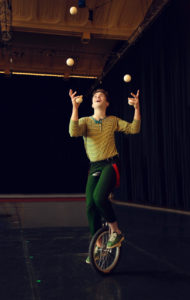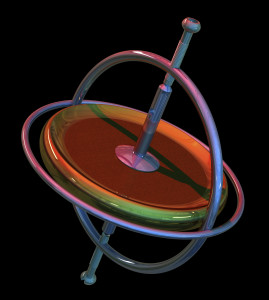As bipeds with mobile shoulder and hip joints, human beings have a wide range of motion available. Yet physical challenges, such as the force of gravity and our heavy heads, limit the extent to which we actively tap fully three-dimensional movement. And mental habits can also limit our access to space.
Rudolf Laban succinctly identified two cognitive maps of space. The first is the dimensional cross and the cardinal directions of up and down, right and left, forward and backward. Laban relates these movement directions with stability.

In contrast, Laban also identified four diagonal lines of motion. Think of these as radiating lines that connect the opposite corners of a cube or rectilinear room. Laban relates these sharply tilted lines with mobility.
Then Laban makes an interesting observation. Since most movements are neither completely stable or totally mobile, “the trace-forms of living matter” follow trajectories that lie between the dimensions and diagonals.
Laban went on to develop lengthy sequences of movement that follow these deflected pathways. These lines of motion, which are more subtle than normal cognitive maps of space, are mentally challenging. Moreover, they physically test balance and range of motion.
Nevertheless, Laban’s choreutic models encourage living fully in three dimensions. Find out more in the forthcoming MoveScape Center correspondence course.





 Mastery of Movement is for body and effort what Choreutics is for space and shape – the most comprehensive treatment of Laban’s ideas in English. The book has an interesting history.
Mastery of Movement is for body and effort what Choreutics is for space and shape – the most comprehensive treatment of Laban’s ideas in English. The book has an interesting history. Rudolf Laban thought so; he found them in the kinesphere! “Snakes” are one of the seldom taught space harmony forms that Cate Deicher and I will be exploring in our
Rudolf Laban thought so; he found them in the kinesphere! “Snakes” are one of the seldom taught space harmony forms that Cate Deicher and I will be exploring in our  Since 1991, Motus Humanus has been serving the Laban community by providing various services to support movement professionals as they develop their post-certification careers. These include the following.
Since 1991, Motus Humanus has been serving the Laban community by providing various services to support movement professionals as they develop their post-certification careers. These include the following. In 1975 Buckminster Fuller coined the term “tensegrity” by contacting two terms — tensional and integrity. Simply defined, tensegrity refers to “compression elements in a sea of tension.”
In 1975 Buckminster Fuller coined the term “tensegrity” by contacting two terms — tensional and integrity. Simply defined, tensegrity refers to “compression elements in a sea of tension.” For many years, I have been puzzled by Laban’s emphasis on the cubic diagonals. He has embedded these oblique internal lines, which connect opposite corners of the cube, in his theories of both space and effort.
For many years, I have been puzzled by Laban’s emphasis on the cubic diagonals. He has embedded these oblique internal lines, which connect opposite corners of the cube, in his theories of both space and effort.